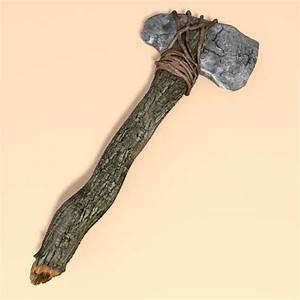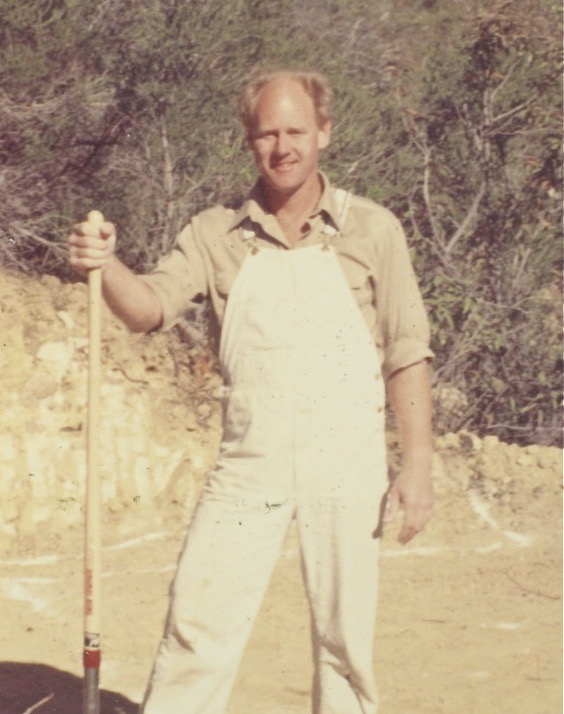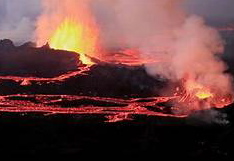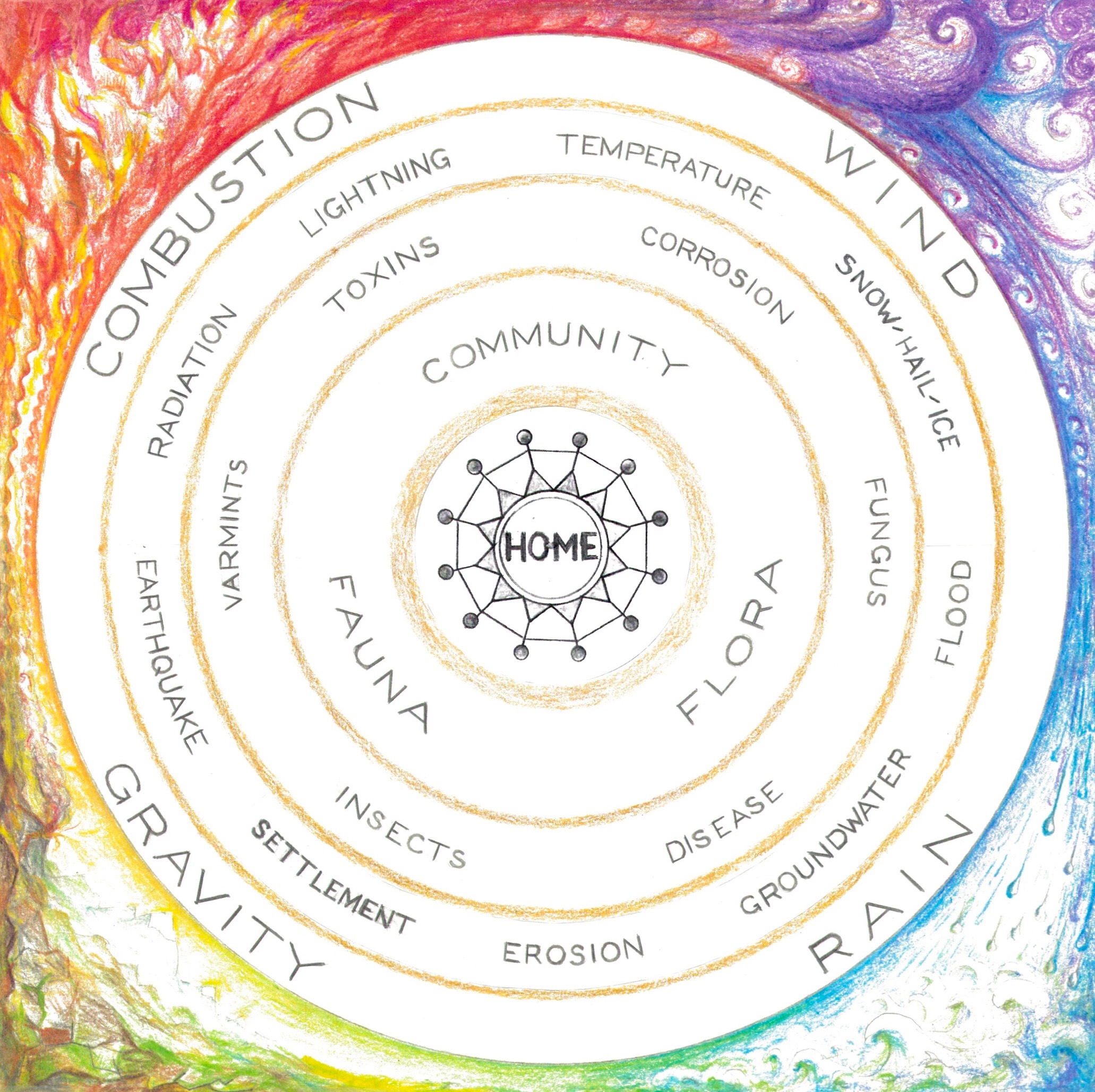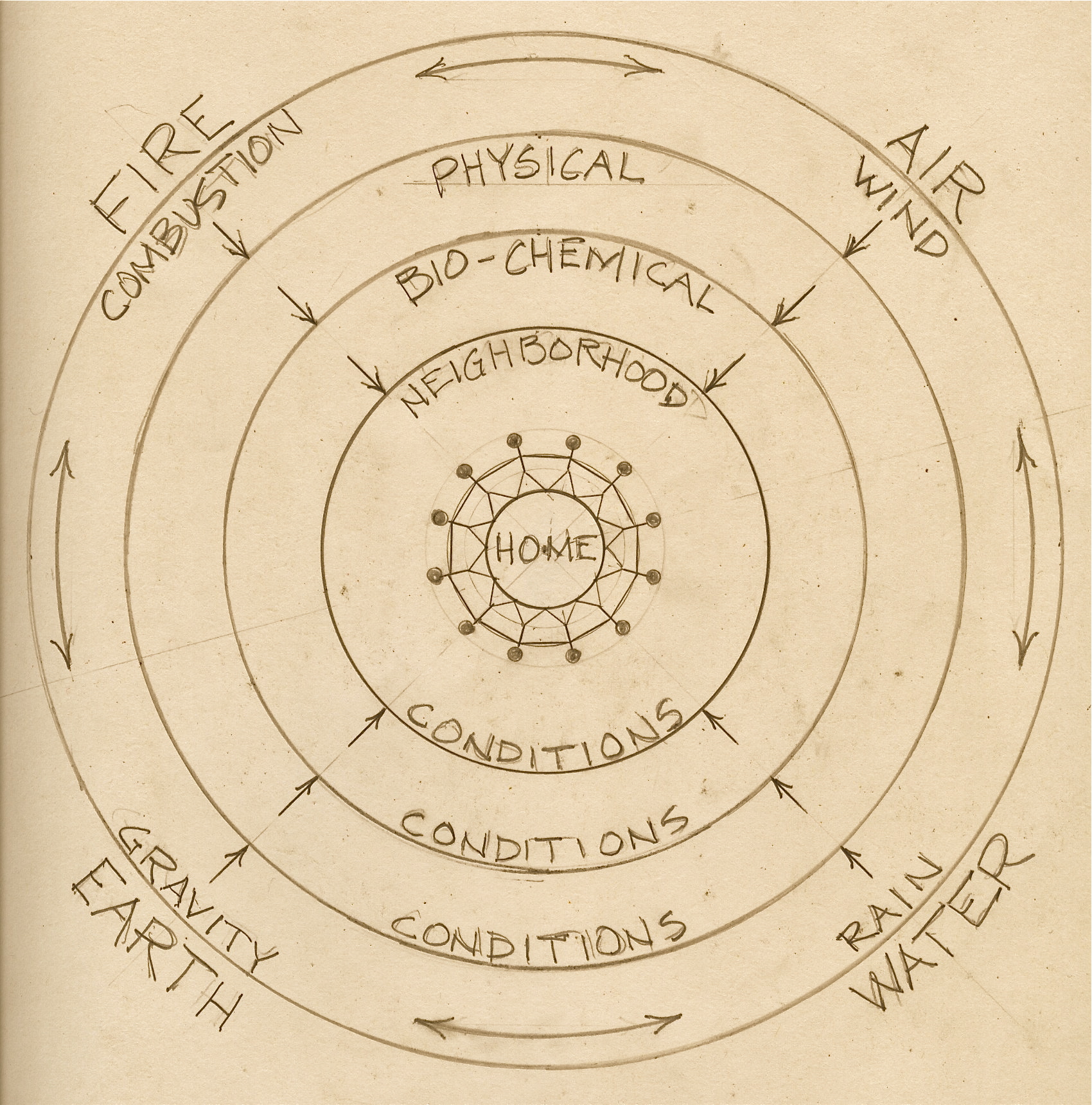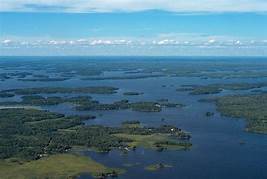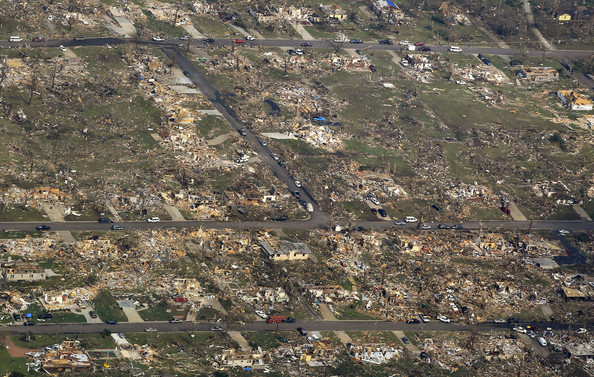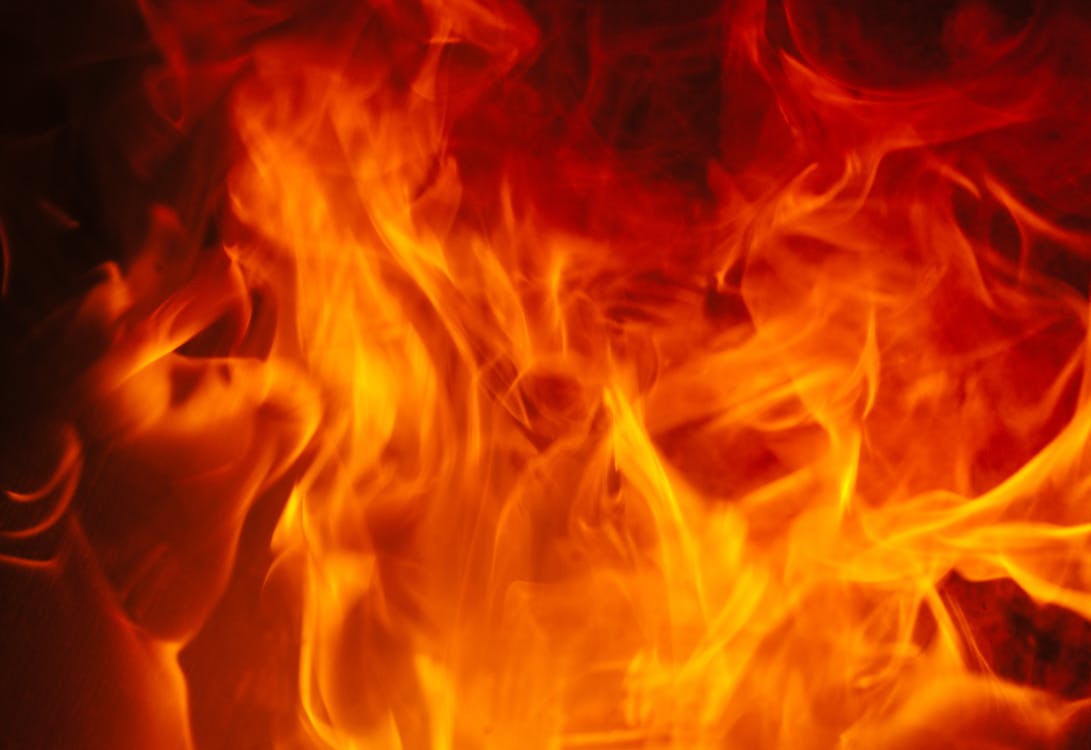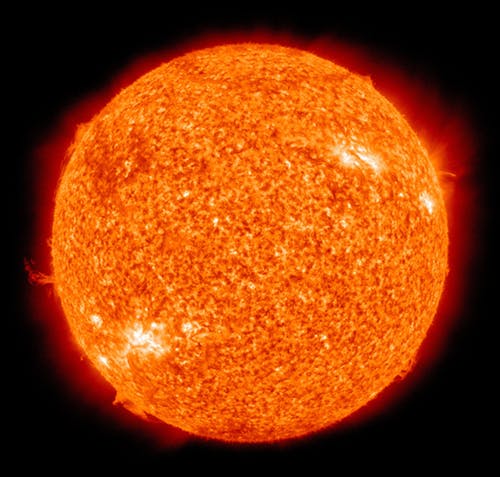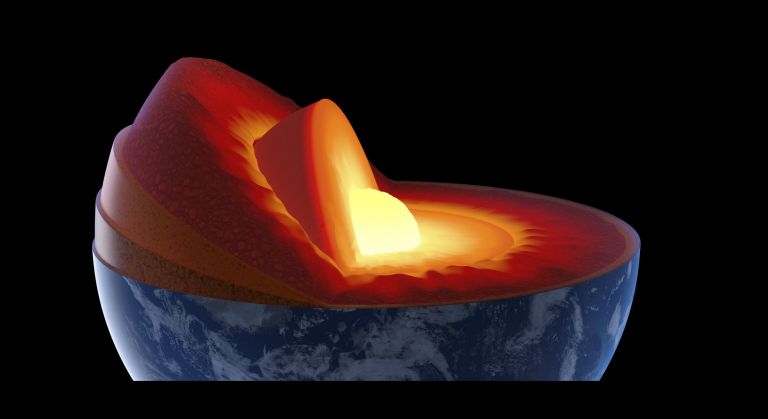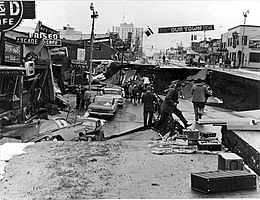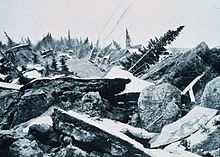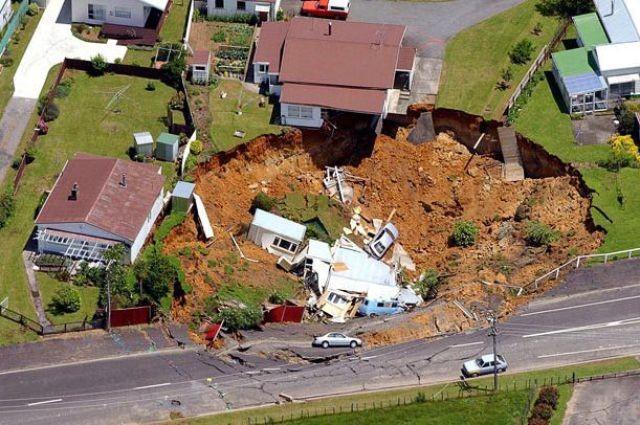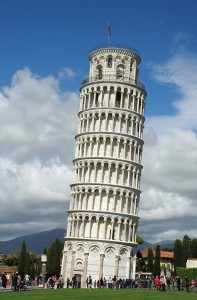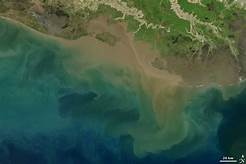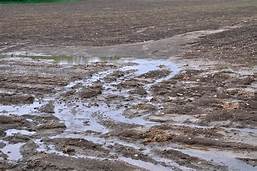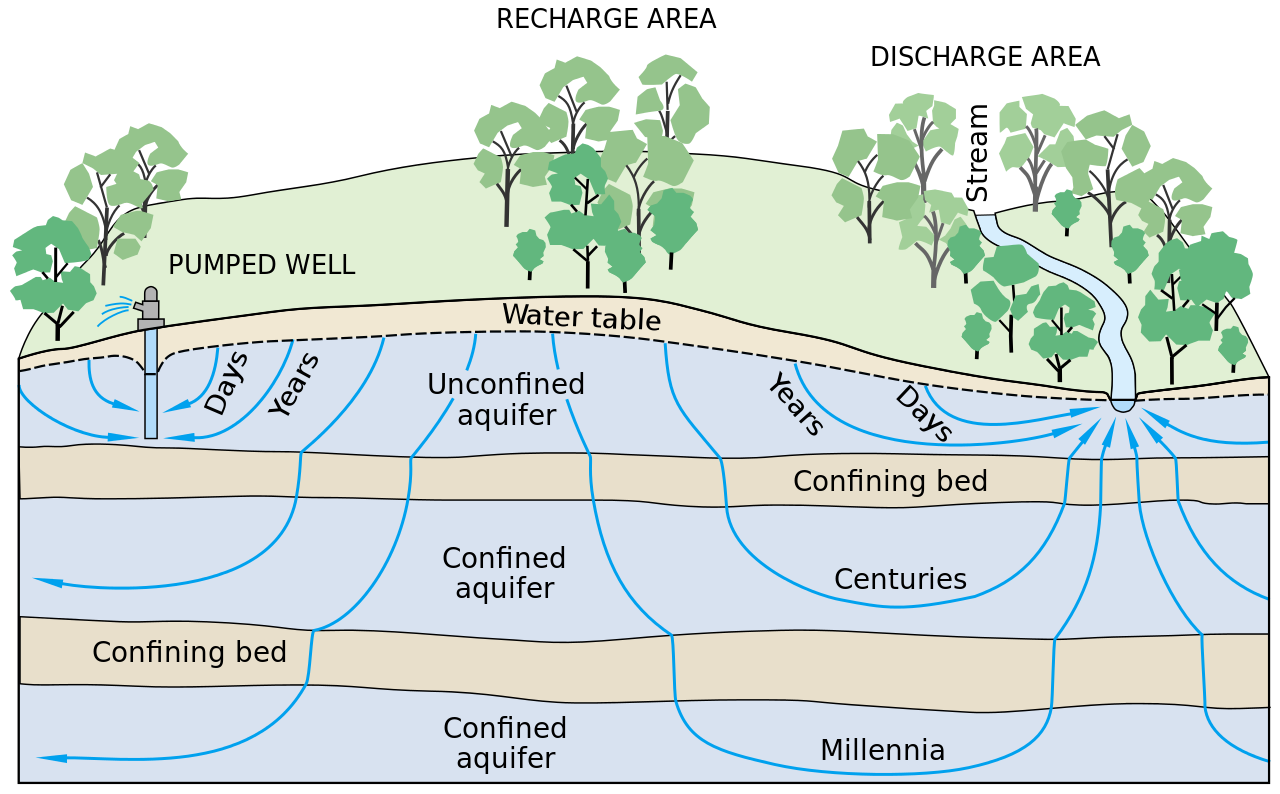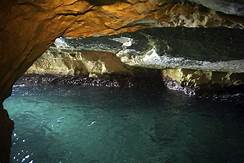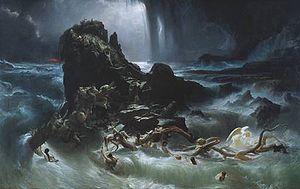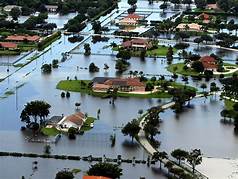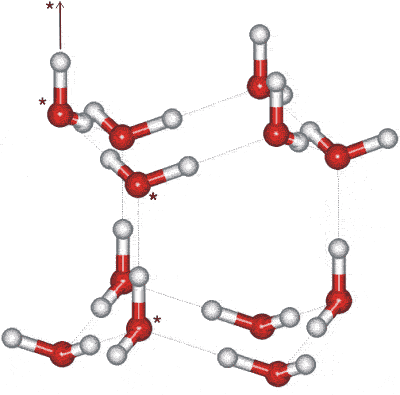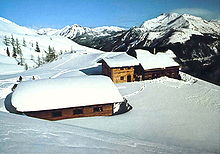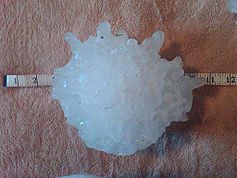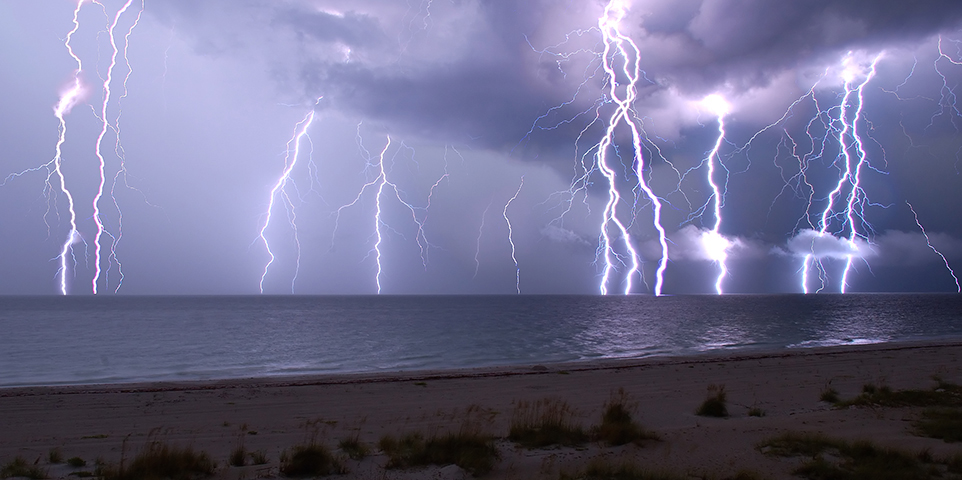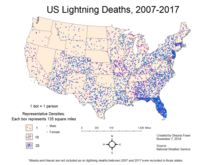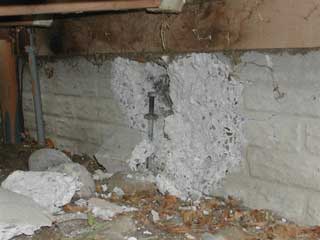
HouseBuilder original
You are here : Home > HouseBuilder original
HOUSE BUILDER
IN THE BEGINNING
Building — the creative process of shaping and assembling materials into useful objects and structures — is surely one of the fundamental human instincts, deeply embedded into our DNA. People are passionate about making things, large and small, deriving pleasure and satisfaction from the process. As evidence, just contemplate for a moment the stupendous development of our civilization and the surrounding infrastructure. It’s truly mind-boggling what has been created! The urge to use one’s hands to shape and embellish our environment stirs in every heart and mind, almost without exception … and it makes perfect sense that this should be so. Our survival as a species was greatly aided by developing the ability to make the clothing, weapons, shelters, tools, and utensils we use for daily living. We are not endowed with the fangs and claws of the lion, the hide and horn of the rhinoceros, or the wings and eyes of an owl, but we can intelligently manipulate our surroundings. It turns out that this ability is perhaps the most powerful evolutionary adaptation of all and it has made man supremely successful. Building things is at the heart of our well-being.
For me, the realization I could manipulate my environment came when I was very young. Inventiveness arose from some deep and unknown well-spring, filling my imagination with ideas for reshaping the world. Left-over kite string became an elaborate web in my room linking bed-frames, door knobs, window latches, light fixtures and closet hooks. Tables, couches, chairs, and other furniture throughout the house seemed to constantly be in need of rearrangement (much to my parent’s exasperation). Our backyard became the site of dark underground tunnels and chambers, complete with hidden entrances, and including a volcano which actually belched smoke and fire. As time went on my planning became more elaborate and drawing emerged as a vital part of the creative process. I began to collaborate with friends. We made plans for amusement parks, forts, carnivals, burger-stands and hideouts … some of which we actually managed to build. We used an assortment of tools and realized the potential they held while simultaneously searching out new materials to work with. Obviously building was in my blood, so it is easy to understand why I chose residential design and construction as a career and as my primary means of expression.
Home building encompasses only a small fraction of human industry, yet it embodies the whole of the building process as well or better than any other undertaking I can think of. Beginning with the germination of an idea, proceeding through the planning and labor of the actual construction, and including the assumption of social and environmental responsibility within a community, building a house requires artistic and utilitarian invention, collaboration, resource allocation, craftsmanship, and good-old physical effort. People’s dreams for their home never stop growing and changing. Even a simple structure may include thousands of parts formed from hundreds of materials which require an understanding for how these behave with each other and with the environment. Each of these separate parts requires unique tools designed specifically for their installation and assembly, as well as the skill to apply them. The sites which people have chosen to inhabit span the breadth of the globe, ranging from the coldest and wettest to the hottest and driest, from the highest rocky precipices to the lowest tidal mudflats, and from steaming jungles to barren tundra. In addition, the rich history of home building, spanning across thousands of years, is thoroughly documented in enough volumes of practical knowledge to fill a library. Topics like architecture, structural engineering, trade skills, material science, and construction codes are covered in detail along with vivid personal accounts of success and failure. For anyone interested, there is enough in this field to fill a life-time with challenging and satisfying work, endlessly varied and vital.
This thesis, ‘House Builder’, is the culmination of a life-long passion for home building and an expression of the knowledge and insight forged by more than 50 years of hands-on experience in the field. It has been brewing inside of me as far back as I can remember and it seems the time has come to record my experiences and understanding in some sort of organized fashion. More than anything else, the idea of mentoring is providing my inspiration and perpetuating the craft of designing and building houses will be my primary focus — creating a ‘How-to’ E-book with the widest possible perspective, intended for anyone interested in learning the trade ‘from the ground up’. The Internet has made it possible to write and assemble amazing publications which include beautiful pictorial images and links to informative associated websites, so this medium seems like to best place to work. As I begin writing, I really don’t know where it will lead but the desire to contribute and add my story to the others that have come before and the many that will follow is strong. To be a part of the ever-expanding saga that will surely out-live me seems important. Hopefully the effort will be enlightening and the outcome useful.
DEDICATION
I want to dedicate this work to Frank Ray Angelillo, my mentor in the art and science of home building and carpentry, who loved building and loved teaching and inspired me to work hard and use my skills to make things better.
THE ENVIRONMENT
WHERE WE LIVE
One thing I’ve discovered and know for certain …. it’s a wild, wild world we inhabit here on Earth! Extraordinarily complex, our planet supports a biosphere teeming with living organisms of every imaginable description while all around us powerful chemical reactions churn continuously under the influence of relentless geo-physical forces. Not only is our environment astoundingly diverse, but it is forever in a state of flux as conditions change from second to second, decade to decade, and eon to eon. For those of us trying to survive amid this chaos, our habitat is often threatening and at times overwhelming ….. we are extremely exposed and vulnerable to the Elements.
This insight is nothing new …. for thousands of years people have tried to describe and understand these ‘Elements of Nature’ which exert such a profound influence on our existence. The Greek philosopher Plato organized them into four basic groups which he called Fire, Earth, Water, and Air …. simple symbols to represent everything we experience from the environment. The early Chinese developed their own model of the world using similar imagery, as did the Egyptians, the Incas, the Mayans, the Druids, the Aborigines, and virtually every other indigenous culture. Most of mythology is infused with embodiments of the Elements, uncontrollable manifestations of the outside environment that are part of our daily lives. And the same elementary characterizations provide the basis for many of our enduring philosophical and metaphysical systems such as the ‘I Ching’ and ‘Astrology’. Of course modern science has vastly refined and expanded our knowledge beyond these primitive concepts, but the early depictions still have great symbolic value and inspire an abiding interest. The image of the Universe divided into four quadrants, each representing one of Plato’s four Elements, has great appeal. Maintaining an awareness that we are forever immersed in space surrounded by powerful natural forces is essential to our survival and well-being.
THE CLASSIC ELEMENTS
A fifth Element was added to this symbolic order by Aristotle, another Greek philosopher and a student of Plato, which he called the Spirit and placed at the center of the other four. I believe that Spirit represents the essential life force, the inner Element at the core of our being which keeps us alive and animated. The House we design and build will be the dwelling place of the Spirit …. Home will rest at the heart of it all, surrounded symbolically by the earthly manifestations of Fire, Earth, Water, and Air. Materially speaking, our House will be constructed as a structural membrane between these external environmental forces and the people living within its walls and under its roof. Those inside can be threatened by the forces coming from outside but they can also be comforted and nurtured by them. Conversely, the energy which emanates from within the house, from the Spirit, can move outwardly into the surrounding environment, sometimes destructively and sometimes beneficially. It’s always a two-way street. A great 20th- century French architect, LeCorbusier, described the house as a “Machine for Living In” because it is a mechanism over which we have some control, giving us a means to manage this constant ebb and flow of energy. The challenge is to build and use our House in ways that are beneficial, both to the people and Spirit within and to the surrounding Neighborhood outside.
ENVIRONMENTAL PHENOMENA MANDALA
No matter what uses we have in mind for our House, a good design should consider the impact from all of the environmental phenomena depicted in the diagram above. The most important and influential of these, shown in the outermost sphere of the mandala, correspond directly to Plato’s fundamental order: Gravity (Earth), Rain (Water), Wind (Air), and Combustion (Fire). Powerful, pervasive, and mostly beyond our control, these four primary phenomena have affected virtually every shelter ever constructed and in fact were the basis for the original design standards of our Building Codes, way back in the days of Hammurabi. Even today, our current building codes and code-compliance reviews begin with the identification of site-specific environmental conditions. Over time, the interactions between these elemental forces and earthly matter have resulted in a sphere of more-localized Geo-Physical phenomena. Depending on our particular building site we will need to contend with the following conditions: Earthquakes, Settlement, Erosion, Groundwater, Floods, Snow/Hail/Ice, Temperature, Lightning, and Radiation. When we add Bio-Chemical forces into the mix, another sphere of environmental phenomena emerges which includes Varmints, Insects, Disease, Fungus, Corrosion, and Toxins. And closest to Home, in the Neighborhood we depend on for comfort and support, we find the phenomena which are most a part of our every-day lives: Fauna (the Animal population), Flora (the Plant population), and Community (our man-made infrastructure and social living network). What follows is a brief investigation into all of these separate phenomena, from a builder’s perspective, which will provide the background for our decision-making. Our House will grow from an appreciation of, and a respect for, our place in nature.
SPHERES OF INFLUENCE
These natural phenomena are not truly separate from one another but exist in a continuum of time and space, they are processes, and there is a great deal of interaction between them. The diagram above shows conditions in the outer spheres acting directly on the spheres within, which is to be expected, but they don’t necessarily act alone. Often times the most destructive phenomena are caused by two of the primary elements acting together. For example, Wind driven Combustion can result in conflagrations that wipe out entire towns in a matter of hours and every year cause many billions of dollars in residential losses. Gravity acting on our molten pyroclastic planet can unleash enormous amounts of seismic strain energy, leading to epic earthquakes and tidal waves which kill tens of thousands of people. Hurricane Winds and Atmospheric Rivers can carry so much Rain that entire cities and counties end up submerged with their infrastructures in ruins. The rivers carving and re-shaping the land surface are simply Rain under the influence of Gravity. It is worth remembering that nature is highly complex and nothing really happens in isolation. It is also worth remembering that most of these phenomena can also have a huge impact on the construction process itself, often causing problems even before our house is complete.
As we progress through this discussion, it will be useful to imagine designing and building a mid-sized one-story house with 1500 sq. ft. of floor area, 15 feet overall height with a sloping roof, and made of conventional medium-weight materials. This will provide a point-of-reference and means for comparison when considering actual real-world numbers. With every design variable there is a wide range of possible values, so in most cases an average will be used to give a feel for the quantities normally encountered.
PRIMARY ENVIRONMENTAL PHENOMENA
GRAVITY (EARTH)
I’m a Taurus, born in May and bound to the Earth, so naturally my building process starts in the ground, with Gravity. Frank always said this was the best place to begin. Physics tells us that objects with mass are drawn towards one another by the force of gravitational attraction, one of the four fundamental forces of the universe, and so it is Gravity that holds everything around us in place, anchors us to the ground, and keeps us relatively stable as we spin through the vastness of space. Gravity makes it possible for things to ‘stay put’, which from a builder’s point-of-view is obviously desirable …. when you return home in the evening it would be nice to find your house where you left it in the morning. And thanks to an Earth-mass of 597,000,000,000,000,000,000,000,000 Kg., you can count on it. We tend to forget how powerful this force is because we are constantly immersed in it’s field and have adapted to it’s effects, but it is everywhere all the time and will affect the House every day of it’s life. Getting the ‘layout’ right is the first and most important concern for an Architect or an Engineer when starting a new project, both in terms of Siting (sitting?) and choosing a Structural System. As the builder, the heavy-lifting required during construction begins with ground-breaking and continues every day until the last light-fixture is screwed to the ceiling. Building is 90% grunt labor and most of it is necessitated by Gravity.
The idea of stability is fundamental to building a house, both from a structural point-of-view and also from a spiritual perspective. There is a need to be ‘grounded’ and ‘secure’. From the beginning of the design process the plan should shape itself to the local terrain and be bound firmly to it, accepting that this is the condition of rest which nature imposes. Another way to think about stability is to imagine a state of repose, like a cat sleeping on a rock or in a tree, effortless relaxation spread evenly throughout the body while conforming to the landscape nature has provided. Every part of the structure, including the foundation, the soil and the rock beneath it, will bend and compress over time in response to Gravity. If there are any voids in the structure, they will slowly be squeezed down to nothing. Changes to the existing balances of the undisturbed site will result in long-term differential settlements. In engineering terms, all of the Dead Loads and many of the Live Loads used in the Structural Design Calculations are gravity loads, and even our model House will weigh 125,000 pounds or more.
In addition to pure weight, there are several indirect outgrowths of Gravity which also affect the stability of the house, and these will be discussed individually as Geo-Physical phenomena. ‘Earthquakes’ are ground movements caused by circulation of the planet’s magma as it’s density changes due to heating and cooling. This core circulation also affects the planet’s electro-magnetic ‘Radiation’. ‘Settlement’ results from the inexorable downward motion of soil particles to a state of lower potential energy and greater density. Water moving rapidly downhill is the primary cause of ‘Erosion’. ‘Hail’ damage is the result of kinetic energy blasting from the sky. Without the force of Gravity, none of these conditions would exist.
RAIN (WATER)
While Gravity is certainly the most ubiquitous of all the primary elements, Rain is undoubtedly the most troublesome. Moisture condenses in the atmosphere above us and plunges to the ground drenching everything in it’s path, then proceeds to infiltrate every crack and crevice to the point of complete saturation. Water is called the abysmal element because it penetrates steadily downward toward the deepest recesses … into the abyss … and in my experience the most intractable building problems were the direct result of water leaks through the envelope of the house. Swelling, staining, warping, mold, dry-rot, de-lamination, rust, corrosion, electrolysis, short circuits, termites, ants, and general decay are all the direct result of moisture. Poorly ventilated materials which cannot dry-out quickly will prolong and often magnify these problems. High levels of humidity can have long-lasting consequences in terms of air-quality. And even Rain that doesn’t actually penetrate our barrier can have an abrasive effect on the surfaces it strikes, and over time will wear down most substances. During construction, Rain (or even the threat of it!) complicates everything: material storage, site accessibility, safety, protection of un-finished components, and job-site cleanliness are all more difficult to manage and can be very costly.
The amount of annual rainfall one experiences varies dramatically depending on locale, but it is significant almost everywhere. In the U.S., statewide averages run from 9.5 inches per year in Nevada to 63.7 inches per year in Hawaii, and the average across all of the contiguous states is 30.21 inches per year. In Alaska, some regions get as much as 237 inches annually, and on the island of Kauai the number goes all the way up to 460 inches. Given that the area of the continental U.S. is 3,119,885 square miles, we can figure that an average of 1,638,000,000,000,000 gallons of water falls here every year … approximately 5 million gallons per person! No wonder Earth is sometimes called the ‘Water Planet’. In terms of our model House, nearly 120 tons of water (almost twice the weight of the structure itself) will impact directly on the roof each year and if it were to come down all at once it would squash the structure flat. For those seeking alternative energy sources, the kinetic energy of the Rain hitting the roof is approximately 50 Mega-Joules or 14 Kilowatt-hours annually.
THE WATER PLANET
Rain is also a driving force behind many other geo-physical phenomena. Groundwater, which lurks nearly everywhere just below our feet, is continually being recharged by rainfall, rising and falling throughout the seasons and long-term drought/flood cycles. Erosion is the result of Rain transporting soil and rock downhill while changing the shape of the existing terrain as it goes. Flowing towards the low-lands, the run-off forms bodies of water which often cover hundreds of square miles in vast sediment-laden Floods, inundating the countryside for days or weeks at a time. In the form of Snow or Hail, atmospheric moisture can cause major structural damage, both as a result of impact and from serious over-loading. And rainfall can turn into Ice which is capable of splitting apart solid rock, not to mention our roofs, foundations, driveways, patios, and plumbing systems. In the bio-chemical sphere, water is the fundamental ingredient necessary for the growth of Insects, Disease, Fungus, and Corrosion. We need to be vigilant as we build because given the tiniest opening, water has a way of getting into everything.
WIND (AIR)
The atmosphere that surrounds the Earth, like everything else we find here, is held in place by the force of Gravity because it has mass. A huge mass. It consists of gases and suspended microscopic particles which seem to be weightless as they float around and above us but are, in fact, immensely heavy and somewhat dense. As with Gravity, we tend to ignore the atmosphere because we are continuously immersed in it and have adapted to it’s physical effects so that we no longer ‘feel’ what’s around us all the time. And yet, the atmospheric pressure at sea level averages about 14.7 Pounds/Sq.In. which means that the skinny column of air standing on top of 1 Sq.Ft. of area (about the size of your head and shoulders) weighs about 2117 Pounds. On the roof of our 1500 Sq.Ft. model House sits a mass of nearly 1,600 Tons pushing down (supported, thank goodness, by the same pressure inside the House pushing back up). The total mass of the Earth’s atmosphere is about 3,000,000,000,000,000,000 Pounds.
When this mass is set into motion, the phenomena we call Wind, as radiant energy from the Sun is converted into kinetic energy, the impact to those of us stuck on the ground can be tremendous. The strongest winds, traveling at more than 300 Mph in the center of a tornado, are impossible to defend against no matter how well we build, and despite our best efforts thousands of homes are damaged or destroyed every year by hurricanes with winds exceeding 150 Mph. Wind rattles our windows and doors, vibrates our roofs and walls, knocks over trees and fences, and can drive rain-water sideways with as much force as if it were falling straight down. Even relatively gentle winds can create dynamic effects capable of tearing bridges and towers to pieces (see Galloping Gertie). During the course of construction, Wind can cause serious difficulties which must be dealt with to avoid damage or injury: incomplete structural systems require temporary bracing, tarps and canopies need additional lashing, work may have to be curtailed for safety reasons, and the threat of fire is much higher.
JOPLIN TORNADO 2013
From a structural perspective, Wind pushes and pulls on the House from virtually every direction as the air pressure responds to the geometric shape of the building. Every surface is affected differently with inward force or outward force assumed to act in a perpendicular direction, and the magnitudes of these forces are dependent on several factors. Every locality is rated in the Building Code according to the minimum wind speed that must be considered. In addition, sites are categorized according to their Exposure based on terrain and nearby trees or buildings. Wind forces must be assumed to act in the North/South direction as well as the East/West direction and each direction must have an independent lateral load-bearing structure. Uplift forces, particularly on eaves and open roofs, can be problematic and in hurricane-prone areas, consideration must also be made for flying debris (air-born missiles). In vulnerable locations, a Professional Engineer should be consulted as part of the design process, particularly if the structure is more than one story tall or has an unusual shape.
A NEW DAWN
Like Gravity and Rain, the Wind is instrumental in creating some of the other geo-physical phenomena. The vibrations in our roofs and walls contribute to fatigue, which can lead to failure in certain materials. The churning updrafts of a thunderstorm lead directly to the creation of Lightning and Hail. And air masses moving between geographic regions can result in dramatic Temperature changes over very short periods of time. Wind is constantly stirring the pot, mixing and moving the air and doing more kilo-watts of work in a single day than all of humanity expends in a year. As we search for alternative and renewable energy sources, we are beginning to harvest some of that power by using large Wind Turbines and Ocean Wave Energy to generate electricity.
COMBUSTION (FIRE)
The final and most immediately recognizable of the four primary elements is Combustion. At it’s most dramatic, fire erupts from nowhere and within minutes explodes into an all-consuming inferno, incredible to behold. No one who has witnessed such a conflagration will ever forget the heat and smoke and dazzling radiant energy which fills the air, spreading terror and devastation in every direction. Sometimes nothing survives. Even in it’s more benign appearances, the phenomena of Combustion is endlessly fascinating because all our senses are stimulated simultaneously and the effect is almost magical. The controlled use of fire has been an integral part of man’s lifestyle for more than 125,000 years — heating our shelters, cooking our food, lighting our way at night, keeping predators at bay, and ultimately providing most of the energy needed to power our civilization. And with the increasing realization that human activity is directly responsible for raising the temperature of the oceans and the atmosphere, we come to understand how significant this element of nature really is. As designers and builders, we should do everything reasonable to limit the destruction caused by Combustion and make the most beneficial use possible of the energy we derive from it.
In the field of Fire Science, combustion is defined as an exothermic oxidation-reduction (Redox) reaction wherein materials undergo chemical change as atoms and electrons recombine, forming new compounds and giving off heat as it progresses. Nearly always, Oxygen plays a vital role in the process because of it’s accommodating electron structure which allows it to recombine easily … and because it is so readily available (one third of the mass of the Earth, 88% of the oceans, and 21% of the atmosphere are Oxygen). Redox reactions can progress slowly or quickly, and the faster they go the more heat they generate. Every material has an ignition temperature, and if a fire gets hot enough and there is adequate Oxygen available, then virtually everything in the vicinity can add to the fuel-load and accelerate the reaction even more. Uncontained fires can reach temperatures close to 2000 Degrees Fahrenheit. In the aftermath of an intense fire, it often seems like there is nothing left. Fire prevention is largely a matter of reducing the exposure of materials with low ignition temperatures, and restricting the flow of Oxygen. Fire suppression is accomplished by sucking the heat energy out of the reaction with water (which is vaporized) or by displacing the available Oxygen using fire-extinguishers, retardants, or blankets.
THE SUN
This is a good point in the discussion to talk about our local fire-ball, the Sun. Although the reactions occurring there are definitely not Redox reactions, they can certainly be thought of as Combustion because they consume fuel and emit radiant energy much like fires here on Earth. In fact, there is so much radiant energy coming from the Sun that Earth’s ocean currents, atmospheric winds, and all plant growth would cease immediately if it were to disappear, not to mention that the temperature here would plummet to almost nothing. Without the Sun, life on Earth would most likely disappear. We need energy, lots of it, and the Sun is our source. With a mass 333,000 times that of Earth and a surface area 12,000 times as large, it is estimated that the Sun will continue to burn for another 5 billion years as it converts 4 million tons of matter into pure energy every second (non-renewable, I might add). What reaches Earth’s surface and gets absorbed amounts to 240 watts per square meter averaged over the entire surface, 24 hours a day, 365 days a year, which is about 6000 times mankind’s annual usage. So luckily, because of the burning Sun, there is lots of energy available for our purposes …. we just have to learn how to manage it better so that we don’t kill ourselves in the process. The photo below shows the energy that Earth is radiating into space, which almost exactly balances the total amount we are absorbing. The slight difference we are currently experiencing, caused by a dramatic change in the atmospheric gases, is the source of ‘Global Warming’. And as we are doing with Wind energy, we are slowly improving our capacity to turn radiant energy from the Sun directly into electrical energy and hydronic heat by using solar collectors.
EARTH’S RADIANT ENERGY
When it comes to the construction of our House, Combustion plays a huge role – and mostly in a positive way. Of course we need to be prepared for the possibility of fire on the job-site, and great care should be taken to prevent it, especially if conditions are dry and windy. Consideration should be given to using fire resistant materials and design details which inhibit the spread of fire. But overall, we derive a huge benefit from Combustion because it provides the energy to do a lot of our work. First of all, the 125,000 pounds of new material we require must be manufactured and brought from far and wide to our location, and an equivalent amount of dirt and debris will need to be moved or hauled away from the site and disposed of. Then this new material must be processed, lifted, and secured into place using powered machinery: electric tools, compressors, heaters, generators, pumps, cranes, lifts, welding equipment – and let’s not forget the food truck – all get their energy primarily from some form of Combustion. Like it or not, it isn’t possible to build a House without it, but we should be smart about how we use it.
GEO-PHYSICAL PHENOMENA
EARTHQUAKES
…. so back to the dirt.
The ground beneath our wandering feet may feel like solid earth, but it really isn’t. What it is, is a thin shell of broken and reconstituted mineral formations (the Crust) floating on the surface of a hot visco-elastic sphere consisting mostly of Iron (32%) and Oxygen (32%), with some Magnesium (15%) and Silicon (15%) thrown in. Under Gravity’s influence, enormous convective currents in the Mantle carry heat to the surface and then move back toward the Core as they cool and densify. In the process, the Crust is contorted to the breaking-point, whereupon huge amounts of elastic strain energy are released sending Seismic Body Waves in every direction. This phenomena is called an Earthquake and throughout the world hundreds occur every day (although most of them are too small to be noticed) …. everything is vibrating all the time. Occasionally, so much energy is unleashed during an Earthquake that violently destructive body waves shake thousands of square miles of land area and tsunami waves travel around the globe. In the largest Earthquakes, like the 1964 Anchorage quake in Alaska or the 2011 Fukushima quake in Japan, the energy reaching the surface is about 1500 times greater than the Hiroshima atomic bomb explosion.
OUR MOLTEN PLANET
The vulnerability of our House to Earthquake damage depends on several important factors which should be considered as part of the structural design. First, of course, is where we live relative to active faultlines. Every location in the U.S. has a Seismic Zone designation that indicates the likelihood an Earthquake will occur and how strong it might be. Most of California, for example, is seismically very active while Minnesota and the Dakotas are quite secure and unthreatened. Secondly, the local soil conditions down to about 100 feet deep will determine the nature and destructive capacity of the seismic waves reaching our foundation. The Soil Profile designation for the site tells us whether we should expect high velocity, high frequency P-waves because we sit on hard rock or the far more destructive high amplitude S-waves because the soil under us is soft silt and clay. If we live on the mud-flats around San Francisco Bay, we need to be concerned …. next to Mount Rushmore, not so much. The third factor to consider is the type of Structural System used to resist the lateral earthquake forces when they arrive. Some systems have more ductility than others, making them less vulnerable to failure during extreme shaking. In houses, the three most common Structural Systems are ‘Light Framed Walls with Shear Panels’, ‘Ordinary Braced Frames’, and ‘Ordinary Moment Resisting Frames’. The height of the structure also plays a big role in our vulnerability because taller buildings are much more susceptible to tipping over, plus they concentrate the Base Shear into a smaller foundation area.
ANCHORAGE EARTHQUAKE 1964
During an Earthquake the ground moves in every direction and the exact wave forms under our House are impossible to predict exactly, but we can make some assumptions to simplify the design process. First, if the ground moves like it did around Anchorage, as shown in the photos above, no Structural System is going to help …. just hang on tight. Our ability to tame Mother Nature has limits. Second, we can generally assume that the up-and-down motions will be resisted by the same structure that supports the vertical Gravity loads, with the addition of some uplift resistance at the foundation connection. The Earthquake loads we need to design for are assumed to act laterally (side-to-side) in both the North-South direction and the East West direction, and each direction requires it’s own Structural System (similar to Wind loading). Lateral loads are applied at points throughout the structure based on weight distribution (normally at floor levels and the roof level), and the sum of all the lateral loads in one direction equals the Total Base Shear. According the the Building Code, Total Base Shear is the weight of the entire House multiplied by the Seismic Coefficient for our site, which can vary from close to zero up to about .4 (40%). In higher risk zones, seismic design can be complex and is often done by a Professional Engineer, especially if the building is more than one story tall.
SETTLEMENT
Some people think of the Earth as a living, breathing organism, and as an analogy the image is wonderfully apt. Like a giant sponge, the ground under our House expands when it gets wet and shrinks as it dries out, compresses when weight is applied and rises up again when the weight is removed. Soil slumps and creeps and oozes and slides. In cold regions, it can freeze solid, heave, and then thaw to mush. Where it is baked by the Sun, soil cracks, flakes, and chips to dust. And just below the surface, Nature has provided a multitude of little earth-movers to keep everything stirred up: fungus, plant roots, worms, ants, termites, gophers, and ground squirrels are constantly at work tunneling underground. As small as they are, ants alone comprise 15% to 20% of the terrestrial animal biomass, exceeding the total of all the vertebrates (including whales and elephants) combined. When coupled with the force of Gravity, the result of all this churning activity is the phenomena called Settlement.
Every time a bit of soil moves, whether it’s a single grain of sand or an entire mountainside at once, Gravity pulls it downward toward a state of lower potential energy, where it is more stable. Following the path of least resistance, particles move into any voids below them and sometimes slip sideways as they go. Over time, the soil tends to become denser and more compacted with a resultant drop in the ground level, often including some lateral movement. Hillside creep occurs in expansive soils even on very gentle slopes, and steeper terrain is often prone to slumps and landslides, particularly when the ground is saturated. The Building Code specifies set-back requirements for houses supported on soil near slopes, and often times the foundation design must include retaining walls, piers or pilings, and grade beam systems to counteract the forces of Settlement.
LEANING TOWER OF PISA
Perhaps the most overlooked aspect of Settlement is differential sinking under separate parts of the House. Though rarely fatal to the structure, Differential Settlement is often the cause of some very well-known problems. Cracks appearing in the walls at door and window corners usually indicate one side of the opening has dropped relative to the other. Sticking doors and windows also happen when the openings change shape. Improper drainage which develops in patios and walkways, as well as in some flat roofs and gutter systems, may be the result of changes in the underlying ground slope. Visible tilting and tipping detracts from our sense of security, and causes furniture to sit uneasily. It is important to prepare the site before building to ensure uniformity in the soil mass across the entire footprint and to create an effective drainage system. Sites with widely varying soil-types need special design consideration and should be surveyed by a Soils Engineer or Geo-Tech consultant at the beginning of the design process.
EROSION
What I would really like to see is a time-lapse movie showing a thousand years of ground movement in one place shortened to about two minutes of viewing time. A lot can change in a thousand years, but with the soil these changes usually happen in very small increments, almost invisible to the naked eye. We think we’re sitting still. In the movie, though, the ground would appear as a gigantic blob, shrinking and swelling, melting and creeping down hillsides, filling up lakes and rivers, and dragging rocks and houses and other hard objects around in the process. The houses, if they could survive that long, would appear like boats bobbing on the surface, drifting along with the currents moving in the soil. It’s funny, but as a house builder, the notion I was also building ships was always in the back of my mind.
Erosion is basically the flow of soil and rock from one location to another, normally under the influence of water but occasionally the wind. Rain drops striking the ground abrade the surface and particles are carried away some distance, then redeposited. On a huge scale over millions of years, Erosion was responsible for carving the Grand Canyon and forming the Mississippi River Delta, but the phenomena can occur on a much smaller scale and still have a big impact. On the low side of our House, for example, foundations can be slowly undermined as the soil washes away, causing them to crack and tip sideways. On the uphill side, dirt is deposited against the structure which can eventually lead to severe rot and infestation problems. Deposits behind and above retaining walls can significantly increase the force they must withstand. And even on relatively flat sites, Erosion can cause ponding and sedimentation which may compromise the drainage systems.
The stability of the soil, especially the upper few feet near the surface, is greatly affected by plant growth. Roots growing underground can raise the level of the dirt several inches over a relatively short period of time, thus contributing to uneven Erosion and altered drainage patterns. At the same time, however, the tangle of fibers that makes up the root mass is very effective at holding onto the soil so it doesn’t wash away. Often, during the construction process, little concern is given to the surrounding plant life and it is badly damaged, leading to Erosion problems a few months or years down the line. Managing the ground cover around the House, including the hardscape and the irrigation system, is the best way to prevent Erosion.
GROUNDWATER
Not all the rain that falls to the ground washes away toward the ocean …. most of it infiltrates the soil and becomes part of the Groundwater which is constantly moving beneath us. As it sinks downward the rainwater reaches a level called the Water Table, below which the ground is totally saturated, and it goes no further. If a hole is dug below this level, water will appear at the bottom and will rise to the level of the surrounding Water Table. When more rain falls, the level slowly rises and when the rain stops the level begins to drop, creating an annual cycle that is fairly predictable. Longer-term fluctuations in the drought/flood cycle can lead to dramatic changes in the water table level that last for many years. Deep below the surface, water collects in Aquifers where it may be held for centuries or millennia before it finds it’s way back into circulation.
Water is essential to our survival …. we can barely go a day without it …. so managing our water supply as the human population increases is becoming more important every year. Of all the sources at our disposal, it will probably turn out that the subterranean Aquifers are the most important component of our water storage and distribution system. In the U.S. there is more water underground than in all the lakes and reservoirs on the surface combined, including the Great Lakes, adding up to about 20,000,000 gallons per person. By drilling wells we have access to these underground reservoirs and can make use of them in beneficial ways, but to remain valuable they must be maintained in optimal condition. If too much water is sucked out without recharging, the overlying soil subsides, sometimes many feet, and the Aquifer becomes permanently smaller. Pollutants such as household chemicals, fertilizer, pesticides, and sewage need to be controlled to keep them from poisoning the water supply and making it unusable. The health and vitality of stream beds and wetlands can be easily ruined if the Groundwater feeding them is degraded or eliminated. Groundwater, although invisible to us on the surface and easy to forget, is one of our most precious natural resources …. as builders, we should keep in mind the impact we have on it.
From the beginning, our House design will improve if certain engineering aspects of Groundwater are understood. For one thing, the bearing capacity and the shear strength of the soil, as well as the lateral pressures exerted against retaining walls, are highly dependent on moisture content. For another, seepage into basements and excavated living spaces is far more problematic when the water table rises. Groundwater drainage systems (French Drains) are often essential, and on more challenging projects the assistance of a Hydrologist or someone with drainage experience can really help. Septic seepage pits and drain-fields, irrigation systems, and run-off diffusers should all be considered in the planning. During construction, groundwater infiltration into drilled pier holes and footing excavations causes cave-ins and sedimentation, and temporary slopes can collapse unexpectedly.
FLOODS
Tales of ‘The Flood’ have been part of our folklore forever, and building to survive the deluge dates back at least as far as Noah, when God delivered the blueprints for the Ark. So by now, we should know how to prepare. And yet, short of building a boat, the only sure-fire way to avoid Flood damage is to move to higher ground. If the flood-waters rise, and the House isn’t swept away downstream, every part of the submerged structure will rapidly become totally saturated, inside and out. All the consequences of rain-water leaks are multiplied many times over, plus flooding brings additional threats from toxins and pollutants (and the occasional Water Moccasin or Alligator). Doors and cabinets swell, flooring buckles, drywall and insulation are ruined, and fungus begins to grow almost immediately. Electrical, mechanical, and plumbing systems may need to be completely re-built. And dealing with the clean-up is a horrible mess. Floods may not pack the short-term fury of earthquakes, fires, and tornados, but in their own slow-moving way they can be just as destructive.
‘The Deluge’ by Francis Danby
The good news about Floods is their predictability …. historically and scientifically, the extent of potential flooding is well known throughout every region. Flood plain boundaries are well defined with maximum water levels limited by local geography, and local building and planning departments have maps showing 50-year, 100-year, and 500-year forecasts. The bad news is that this knowledge hasn’t stopped people from building within these boundaries, where the land is often lush and beautiful while the threat is seemingly remote. At the extreme, Houses built on beach-front property are highly desirable but at the same time bear the greatest risk from flood damage. Apparently, ‘You pays your money and you takes your chances!’ when it comes to buying ‘bottom land’. Flood insurance in some areas is impossible to obtain, and when it is available it can be extremely expensive. The Zoning and Building Permit process in flood zones can take years.
Obviously, moving to higher ground is the best solution to the problems of flooding, but there are alternatives and sometimes human ingenuity triumphs …. at least for a while. Simply raising the house is the most common approach, which requires constructing a water-resistant support structure. Graded earthen mounds, pressure-treated wood pilings, reinforced concrete piers, and galvanized steel columns are all viable options, depending on local conditions and ordinances. Sea-walls and levees can be built to enclose protected areas, but this is most often done on a large scale by governmental agencies to create flood-control districts. Probably the most well-known example is in The Netherlands, where thousands of miles of dikes and canals have been constructed to create enormous habitable areas, all below sea-level. Vast areas of the U.S. are protected by levee systems designed to keep flood waters at bay. Maintenance is extremely important with all these approaches and the long-term costs are proving to be very high. When barriers are needed only for a short time, during an emergency or during construction, rocks and sandbags may provide adequate protection to ride out the storm.
SNOW / HAIL / ICE
Sometimes, in colder climates, the moisture falling from the skies undergoes a change-of-state before or after it reaches the ground and it will appear as solid crystals in an array of fantastic shapes and sizes. As simple as the water molecule might seem, the characteristics of H2O are greatly influenced by both temperature and pressure. In liquid form and as a gas, one Oxygen atom forms a covalent bond with two Hydrogen atoms and the resulting molecule is free to move about as water or vapor. But in the low-energy solid state known as Ice, additional weak Hydrogen bonds form between adjacent molecules and fusion occurs. Movement is no longer possible and various packing geometries begin to take shape. Amazingly, these hexagonal crystalline geometries can assume several different forms depending on the exact environmental conditions during their formation. Small crystals can join together with others, growing sequentially larger and larger, and eventually become part of massive accumulations which endure for thousands of years, covering entire continents. As house builders, we don’t really need to worry about glaciers and icecaps (unless you’re building an igloo), but we should definitely consider the shorter-term phenomena of Snow, Hail, and the freeze/thaw movements of Ice. Their effects can often be very damaging.
BASIC HEXAGONAL STRUCTURE OF ICE
I have never lived where it snows, which may or may not be lucky, but a lot of people do. Each year, about 17 million square miles of land in the Northern Hemisphere is blanketed in white, sometimes for months on end, and there are places in the U.S. where the annual snowfall averages close to 90 feet deep. That’s a lot of shoveling. As it accumulates, during a blizzard or over the course of a season, the weight on roofs and platforms can become enormous, so the Building Code stipulates Live Snow Loads for certain geographic regions that must be included in the engineering calculations. When these loads are critical, the shape of the structure may be altered to minimize snow build-up; steeply pitched roof slopes, fences and barricades to prevent drifting, and offset layouts to prevent funneling are all commonly used approaches. Orientation and thermal properties of the structure can also have an impact on how quickly the snowpack melts. At the eaves and in valleys and crickets, ice-dams can form which cause water to penetrate into the building, so screens and heating elements are often added at these places as part of the design. During construction, special provisions such as tenting and space-heating may be required, and sometimes work must be stopped entirely until conditions improve. Working with frozen fingers is really difficult.
Some areas of the country face another freeze-related threat from the skies in the form of Hail. Away from the coasts, towards the center of the continent, conditions are right for intense thunderstorms with updrafts capable of lifting objects high into the frigid upper atmosphere, where Hail is born. Along ‘Hail Alley’ (Colorado, Nebraska, and Wyoming) and throughout central Canada, these storms cause millions of dollars of damage every year. And although the mechanism of Hail formation is not precisely known, the results are well-documented: stones as large as 8 inches across and weighing up to 2 pounds have struck the ground at more than 100 miles per hour; 4 feet of hail fell in less than two hours on a single city block in Denver; golf-ball size nuggets routinely beat holes in the roofs of entire neighborhoods. Metal roof coverings in particular and skylights can suffer serious cosmetic damage even from relatively minor storms. To combat these problems, builders often increase the pitch of the roof and cover the surface with impact-resistant shingles or panels. And in the aftermath of heavy storms, it is a good idea to check carefully for penetrations to prevent further damage due to water intrusion.
On the cold ground, as the temperature fluctuates throughout the winter, water molecules are constantly changing state between liquid and solid, which can lead to an assortment of additional concerns. As Ice forms, the volume it occupies increases by about 9% and the internal forces are so powerful that nothing can stop the expansion …. not rock, not concrete, not solid ground, and certainly not our relatively flimsy houses. As a liquid, water penetrates into every imaginable crevice, and when it subsequently freezes the surrounding materials are cracked apart, which allows more liquid to creep in, which leads to more freezing, and so on and so on. This can be really bad news for roof coverings, flashing, plaster and masonry, concrete foundations, driveways, and walkways. The only real defenses are good water-proofing, ice barriers, and localized temperature control systems. Exposed piping, even in unconditioned attics and wall cavities, needs to be well-insulated and possibly recirculated to avoid ruptures. Hydronic solar panels are particularly vulnerable. Footings must extend below the frost line to avoid the consequences of soil heaving, and walking and driving surfaces should be designed to avoid treacherous glazing. About the only things Ice is good for are food storage and air-conditioning, but alas, the 19th century has come and gone.
TEMPERATURE
Talk about subjective subject ….
People are sensitive beings, after all, and for many of us comfort has become an extremely important aspect of our daily lives. It seems like everybody is either too hot or too cold, or both, every single day of the year. It’s no wonder the story of ‘Goldilocks’ is so popular …. we’re all yearning for that elusive sweet spot …. 72 degrees Farenheit …. ahhh, just right! And now, well into the 21st century, and with the specter of Global Warming on the horizon (or closer), we have the capability for total home environmental control at our fingertips. With increasing sophistication, houses are becoming sealed containers through which the ebb and flow of energy of all forms can be totally prescribed and regulated. Computer controlled ‘Smart’ houses, Solar Net-Zero houses, LEED Certified Passive houses …. the writing is on the wall regarding the future of home building. We can have our creature comforts, but the associated costs, including over-all energy consumption, will continue to rise as we consume to satisfy our increasing ‘needs’. Currently, more than 3/4 of the total energy usage in homes is for raising and lowering Temperatures, most of that for space-heating and A/C, and the costs for building and maintaining the machinery to accomplish this are huge. Managing Temperature is a vital component of home design.
As builders, we should always be conscious of the complexity of our creations and strive for simplicity as a matter of principle. Remember there are trade-offs in every design decision, both long-term and short-term. Everything we make consumes resources and alters the environment in many ways. Civilization is a vast ongoing experiment which is moderated by Costs and Benefits, so in order to prosper we need to be honest and impartial when evaluating our work. When it comes to residential environmental control systems, our Costs for construction include sensors, switches, relays, wiring, ductwork, electrical boxes, special framing, fans, motorized dampers, heat-exchangers, membranes, vapor barriers, thermal barriers, and controllers, as well as the labor necessary to put all these parts together in a functioning order. As we reap our Benefits over a limited life-span, constant maintenance and other operating expenses will be required. Consumption in pursuit of comfort is a highly complex social issue that will continue to be important far into the future, and my best advice is to ‘Live lightly on the Planet’.
HOUSEHOLD ENERGY CONSUMPTION
The importance of Temperature in the design of our House goes well beyond heating and cooling and the subjective issue of comfort. Temperature is fundamentally related to humidity, condensation, and evaporation because warm air can hold more water-vapor than cold air …. cool surfaces can become water-logged while warm surfaces can dry out. Mold, dry-rot, poor air quality, wood desiccation, and insect infestations often develop as temperatures vary, even deep within the recesses of the structure. In addition, every building material has a ‘coefficient of thermal expansion’ indicating how much internal movement can be expected as the temperature changes. Within one material, repetitive expansion and contraction can lead to cracking, the phenomena known as Fatigue. Composite structures made of materials with unequal coefficients will suffer differential movement and often separate over time, causing problems for roofing systems, sheet metal flashing installations, seals at windows and exterior doors, siding, stucco, and metallic mechanical components. During construction, Temperature can greatly affect drying and curing times for various materials, as well as increase their vulnerability to fire. Productivity on the job can drop significantly as the thermometer goes up or down.
LIGHTNING
Much like Combustion, the phenomena of Lightning is so dramatic and captivating, and so immediately destructive and terrifying, that we stand in awe of its power. With booming thunder-claps and blinding flashes, Lightning unleashes huge amounts of energy into the atmosphere in the blink of an eye, while we dive for cover. The effect is shocking. Caused by electrostatic discharge between two electrically charged regions, individual lightning-bolts can instantaneously release billions of joules of pent-up energy. Electro-magnetic radiation in the form of visible light, Gamma rays, X-rays, and plasma spread in every direction, while the rapid increase in air pressure along the plasma channel produces a shock-wave that shakes the Earth (not to mention our eardrums). Each year in the U.S., dozens of people are killed by lightning strikes and damage to our homes results in nearly 100,000 insurance claims averaging close to $10,000 each, both figures similar to those caused by hail-storms and tornados. Lightning also is the direct cause for many of the wild-land fires which threaten millions of rural properties.
Lightning is born in the clouds, where electrification occurs as ice particles and soft hail moving in opposite directions collide with one another and exchange electrical charges in the process. The upper portion of the thunderstorm becomes positively charged and the lower portion becomes negatively charged. The ground below the storm also takes on a positive charge, and when the potential between any of these various regions reaches a critical value, plasma channels up to 3 miles long are formed along which an energy discharge travels, temporarily equalizing the differential. Only about one-fourth of these bolts actually hit the Earth, but even so the global average is about ten ground-strikes per second, 24 hours a day. An active thunderstorm may produce several discharges per minute. The threat varies widely from one area to another, with most lightening occurring over land where warm air mixes with cold, primarily in tropical zones. In the U.S., Florida is by far the most vulnerable place to live when it comes to lightning damage.
In order to prevent lightning damage to our House, there are several measures that can be employed. In most cases, damage occurs as the electric current follows the path of least resistance through materials which melt or vaporize or explode. The best defense is to install a lightning rod system within the structure to carry the current harmlessly from the roof into the ground. This usually consists of heavy gauge metal bars and cables bonded together and exposed near the highest points of the roof. Another preventative is the use of surge protectors on all vulnerable electronic components and household appliances. Outside, a buffer zone around the perimeter of the roof can lessen the threat from falling trees and branches, and can also reduce the risk of fire. To counteract the shock-wave from a nearby strike, tempered window and door glass can be a good idea.
RADIATION
Last in the pantheon of Geo-Physical phenomena is Radiation, the emission or transmission of energy in the form of waves or particles through space or through a material medium. Along with Gravity, Electro-magnetic Radiation is one of the four fundamental forces of the Universe, traveling at the speed of light in a spectrum of wavelengths and energy levels which include infrared, visible light, Gamma rays, X-rays, and ultraviolet radiation. Lower energy (non-ionizing) forms include UHF, VHF, radio waves and micro-waves. The electrons which are part of every atom can be affected by energetic photons in ways that change the nature of the material they comprise (ionization), sometimes with serious consequences. Simple sunburn from a day at the beach is one example familiar to everybody. Skin cancer is another. Fortunately for those of us here on Earth, most high-energy Radiation from space is absorbed by molecules in the atmosphere around us, but some does get through. And just like our own skin, the surfaces of our House can take a beating over time.
Resistance to Radiation, particularly ultraviolet (UV), is an important quality of many home-building products and should be carefully considered during the planning process. Roofing materials coated with mineral granules or made from mixtures like terra-cotta clay and light-weight concrete endure prolonged exposure very well, as do slate tiles. Metal roofing such as copper, aluminum or steel alloy is highly resistant to Radiation, but if it is improperly painted or coated it may suffer cosmetic damage. All exterior paint anywhere on the House should be UV resistant, and surfaces directly exposed to sunlight will require constant maintenance. Oven-baked powder coatings are normally much longer-lasting than coatings applied in the field, especially on metal. On windows and exterior doors, cladding made from vinyl, fiberglass and other plastic compounds is often applied at the factory to ensure longer life and functionality. Window glass can be treated to resist transmission of harmful rays, and many local building codes require glazing with Low- E and low Solar Heat Gain Coefficients. Walls finished with cement-plaster, particularly those with integral color, suffer very little from exposure to Radiation, require almost zero maintenance, and provide a high degree of fire resistance.
Here in the 21st century, electromagnetic energy has come to occupy a place of importance far beyond the concerns from even a few years ago. Nowadays, man-made field transmissions fill the space we live in, and an awareness of their nature has become essential to the design of the House. Issues of interference and potential health hazards are pervasive, especially in urban areas. The National Institute of Environmental Health Science is conducting extensive research into the effects of electro-stress, which may be linked to weakened immune systems, cataracts, birth defects, and various forms of cancer. Proximity to high-voltage transmission lines may call for EMF shielding for the entire house or possibly certain rooms. Individual electronic appliances and fixtures can be shielded in metal-lined closets or metal boxes. As we fill our homes with batteries and chargers, cellphones, computers, office equipment, induction heating systems, and entertainment centers we will require the services of highly trained technical experts to set up and maintain these devices. As we move away from natural gas as an energy source and replace it with electric power, we should anticipate significant increases in Radiation-related concerns.
BIO-CHEMICAL PHENOMENA
VARMINTS
We have come full-circle again on our trip around the Mandala, and now move inward to the next sphere of influence, the Bio-Chemical phenomena. Earth is home to thousands of animal species, all roaming constantly in search of food, water, and shelter. We humans build houses to help provide for our own needs, but simply calling a house ‘ours’ doesn’t mean that some of these other species won’t also call it ‘theirs’ at the same time. After all, our survival needs are quite similar, and what works well for us might also appeal to them. Completely uninvited, these unwanted guests move in and make themselves comfortable in basements, crawl spaces, hidden cavities, attics, garages, vent ducts, under decks and eaves, and even inside the fireplace chimney. Destructive and annoying, these animal pests are the very definition of the term ‘Varmints’. They chew through the walls and wiring, shred the insulation to build their nests, undermine the footings and slabs of the foundation, smell bad, are noisy, unsanitary, and often transport insects and disease wherever they go. At times they can be aggressive and dangerous, not only to humans but also to pets. In their search for food, they can cause havoc in the kitchen and pantry areas, while in the yard they devour our precious plants and scatter the garbage everywhere. As builders, we should do all we can to keep these creatures as far from the house as possible.
Varmints can be categorized into several groups according to their basic behavior patterns and choices of habitat. The Rodents, in general, are the most common invaders and are the most troublesome, thriving in urban neighborhoods as well as in more rural settings. The ‘Big Three’ – Rats, Mice, and Squirrels – prefer to build their nests inside the house and venture outside only occasionally. They are all ‘chewers’ and like nothing better than gnawing their way into the protected recesses of our walls and attics where they can reproduce at an alarming rate. Female rats and mice can have ten or more pups every month. Around their nests, excrement accumulates and the odor can become intolerable while at the same time attracting insects, fungus, and other vermin. Another common group of Varmints includes the nocturnal foragers who prefer to nest in crawl spaces, under decks, or inside nearby storage enclosures. These omnivorous scroungers include Raccoons, Skunks and Opossums who emerge at night to prowl in search of food. If they can get in through the cat-door or the dog-door, they have no qualms about coming right into the kitchen to help themselves. Pet food and garbage containers are particularly attractive. And these sharp-toothed creatures are dangerous because they will attack whoever gets too close to them, not to mention the fact that they are armed with well-developed musk glands. The third group of Varmints resides underground outside the house and primarily threatens the landscaping and irrigation systems. These skillful vegetarian burrowers include Gophers, Groundhogs, and Rabbits, and their digging can undermine patios, walkways, plumbing, and even the foundation of the house. They can devour a beautiful garden in a very short time. The last group of Varmints, the flying creatures, is the least worrisome but can still cause problems. Nesting in eaves and attics, these uninvited guests include Owls, Pigeons, Woodpeckers, and Bats. They are mostly unwanted because they make messes and can attract vermin.
There are several ways of dealing with Varmints in order to keep them from becoming a problem. The best method is to prevent them from entering the house in the first place, an approach pest control specialists call ‘exclusion’. It requires fastidious attention to the exterior surface of the house, using materials and assemblies not easily chewed through, making sure that EVERY opening is plugged to create an impenetrable barrier from top to bottom. As amazing as it seems, Mice can squeeze through holes as small as 1/4″ wide and the Rats can enter through openings as small as 1/2″. All vents and utility pipes must be thoroughly screened. Dog-doors and cat-doors should be provided with security panels. Underfloor spaces can be ‘rat-proofed’ with a thin layer of concrete poured continuously on the ground. Eaves and roof overhangs can be boxed in. In addition to ‘exclusion’, effective Varmint control includes making the living conditions within vulnerable spaces unsuitable. Secure food storage containers should be used in garages, pantries, and basements. Trash and recycling bins should be kept away from the house as far as is reasonable. Chemical deterrents can be placed in cavities and inaccessible recesses before they are enclosed. Beyond these measures, abatement may be necessary using traps and, as a last resort, poisons.
INSECTS
As numerous as Varmints are, they don’t compare in quantity to the thousands of Insect species that populate the biosphere …. more than 5 million by some estimates. And a single species can have billions of members. Insects are everywhere, and they comprise about half of the total animal bio-mass on the planet including the oceans. From an evolutionary point-of-view, Insects have been around for at least 300 million years, beginning with the Beetles and then branching into the Flies about 50 million years later and into the Moths and Wasps 100 million years after that. All true Insects are six-legged creatures classified as Hexapods, but if we’re talking about ‘bugs’ invading our home we should also include the Spiders and Mites (Chelicerates) along with the Millipedes and Centipedes (Myriapods). Each of these groups belongs to the animal phylum called Arthropods. And like the Varmints, they are attracted to our houses by the promise of shelter and nourishment within.
The most destructive species of Insect that threatens a house is the Termite. These ‘detritivores’ get their nourishment from dead wood and other cellulose debris, and if there are enough of them they can devour half the structure: floor joists and flooring, wall framing, door jambs and window frames, and cabinetry. Subterranean Termites live in colonies under-ground but enter the woodwork through tunnels (shelter tubes) to eat and carry food back to the nest. They thrive in moist environments, and in some regions cause hundreds of millions of dollars damage every year. Dry Wood Termites make their nests inside the house, usually in the attic or roof structure, and require much less moisture. However, they are far less numerous than the subterranean species and do only a small fraction of the damage.
Ants are another troublesome species …. as a group comprising about 15% of the terrestrial animal bio-mass. It is their vast numbers that make them such a nuisance as they come by the hundreds and thousands into our home, eating their way through anything they find appetizing. Much like the subterranean termites, ants normally nest in the ground and thrive where there is moisture, and are often found side-by-side with them around rotting wood.
Other crawling Insects that feed on detritus and cause infestations include Cockroaches, Beetles, and Silverfish. Although their populations are much smaller than the Termites and Ants, they are individually much larger and can cause significant damage when conditions are right. These pests are often more prevalent in urban developments.
Flying Insect pests can basically be divided into two groups …. those that nest in the house but find their food outside, and those whose primary reason for coming inside is to eat. The first group includes Bees, Wasps, and Hornets. These industrious social creatures construct elaborate structures from mud and wax which can grow quite large and messy, while they also attract other vermin. I once encountered an attic bee colony which for years had been disposing of their dead in the wall spaces of the lower story, eventually filling them to a depth of nearly 4 feet. Also, these nest builders can be physically dangerous to people and pets because they often attack and sting anyone threatening ‘their’ home.
The second group of flying Insects that we should be aware of includes Flies, Moths, and Mosquitos who are looking for nothing but a square meal. While inside they are mostly asocial, hunting alone for their preferred foods. Flies primarily consume organic waste around kitchens and bathrooms; Moths lay their eggs in clothing which provides food for their young; Mosquitos come only to feast on us.
Finally, we get to the Spiders, perhaps the most misunderstood and most reviled of all the bugs. Nearly everyone hates Spiders …. probably because they are so alien with their eight eyes and eight legs and large, poisonous fangs. It’s understandable. But the fact is that Spiders may be the best deterrent available against all the other insects trying to move in on us. It is even said that the sign of a truly healthy house environment is the presence of Spiders. Obviously they need to be chased into their corners on occasion and the old cobwebs should be swept away, but other than the ‘creep’ factor they offer little real threat (other than Black Widows, which should be eliminated). Spiders can be your allies.
